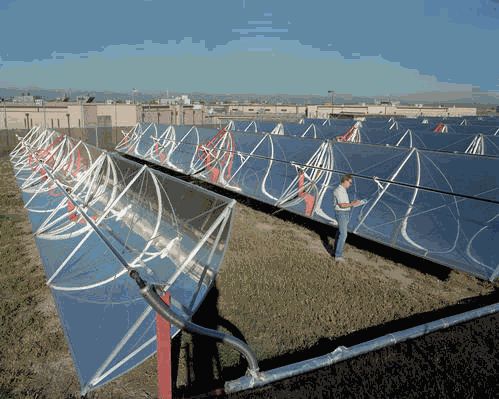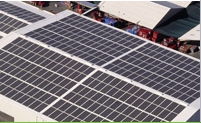Archive for the 'Solar' Category
Solar PV costs predicted to fall 40% by 2010
The Prometheus Institute for Sustainable Development issued a report detailing reasons for this prediction including an increased supply of silicon and increases in production efficiency. There is no doubt solar technology is in the public and policy eye. Recently, the US Department of Energy announced a $22.7M investment in basic research related to solar technologies.
Even with the price drop, unless the market forces change dramatically by 2010, solar PV will still be on the cusp of economic viability, at least at utility scale. At present prices, a megawatt of solar PV power carries costs in the $180/MWh range and has a capacity factor (no storage) of 24%. That means that the annual production per megawatt of deployed capacity is around 2,100 MWh. Compared with wind for instance who’s cost to produce is in the $45/MWh range and capacity factors greater than 35%, it’s still a tough sell even when the price comes down 40%.
Solar technology is advancing and that is fundamentally a good thing in the renewable energy space. But don’t simply believe headlines, there is still significant work to complete before solar PV reaches unsubsidized commercial viability.
Rizhao: City of Sunshine
From Renewable Energy Access:
Buildings in Rizhao, a coastal city of nearly three million on the Shandong Peninsula in northern China, have a common yet unique appearance: most rooftops and walls are covered with small panels. They are solar heat collectors.
A combination of regulations and public education spurred the broad adoption of solar heaters. The city mandates all new buildings to incorporate solar panels, and it oversees the construction process to ensure proper installation. To raise awareness, the city held open seminars and ran public advertising on television.
In Rizhao City, which means City of Sunshine in Chinese, 99 percent of households in the central districts use solar water heaters, and most traffic signals, street and park lights are powered by photovoltaic (PV) solar cells. In the suburbs and villages, more than 30 percent of households use solar water heaters, and over 6,000 households have solar cooking facilities. More than 60,000 greenhouses are heated by solar panels, reducing overhead costs for farmers in nearby areas.
In total, the city has over a half-million square meters of solar water heating panels, the equivalent of about 0.5 megawatts of electric water heaters.
China is clearly very serious about implementing renewable energy. The growth rate of the economy coupled with the sheer size of the population really provides few other choices. One of our principals used to have staff in Beijing and in the winter when the coal plants were going full bore, one couldn’t see across the street to the next building the smog was so thick. It conjures images of Manchester, England during the industrial revolution.
2 comments
The Forgotten Renewable
Renewable technologies are not all created equal, solar and wind are hot. These two technologies grab the headlines and are attracting R&D and implementation dollars in large hunks (solar more of the R&D and wind more of the implementation.) There is nothing wrong with that, both wind and solar have great benefits and anything that increases the footprint of renewable electricity generation is a good thing.
If we look at wind and solar respectively, we’ll notice that they each have strengths and weaknesses (as do all renewable generation technologies) that make it curious, in some respects, that these are the technologies that have caught fire.
Wind for instance, is relatively easy and cheap to develop (it’s pretty easy to see where it’s windy and a site assessment is cheap and quick to perform) on the advantage side. Modern turbines can provide capacity factors approaching 40% if sited well and provide large nameplate capacity of greater than 1MW per turbine. In addition, wind is modular. You don’t have to build a whole project at one time, several phases can be used to schedule the development which spreads cost and risk over time which is attractive to developers.
On the downside of developing wind projects, one doesn’t really know when the wind will blow, how fast, or how long. Yes, good site assessments mitigate this risk to some degree, but one is never quite sure of the wind. Consequently, the power purchase agreements for wind projects don’t bring in as much revenue as baseload technologies, right now, developers are lucky to get $45/MWh on their PPAs. Also, developers buy and install based on nameplate capacity which is now about $1.5M per nameplate MW. But, even with 40% capacity factor and 99% availability factor, at any given time the developer is harvesting only 400KWh per installed MW. Without the production tax credit, it would be difficult to make the numbers work for wind developers.
Solar (PV – not necessarily CSP) brings similar benefits and liabilities to the table as wind. Solar technology readily lends itself to small, distributed installations, something few other technologies bring to the table. As with wind, it’s pretty easy to develop as areas that receive good direct sunlight are obvious and site assessments are cheap and fast. The current generation of solar cells have efficiency levels approaching 20% and have a lifetime of 20 years. Unlike wind, solar remains very expensive to develop coming in around $8M per MW. The expected capacity factor for a solar project is in the 25% range. The cost of maintenance of a solar system is very low however, there are few moving parts and once installed, these systems are very reliable. Also, solar production tends to peak during the times that demand for electricity are at their highest, so the capacity factor and production to demand match is much better than wind.
The obvious disadvantages to solar are cost to develop and capacity factor. There is no way around it, solar is expensive to acquire and install relative to other technologies. The capacity factor of around 25% is also a limitation without sufficient power storage capabilities, which increase the cost of these systems even more. A hidden aspect of solar that isn’t well publisized is that the power produced is direct current and needs to pass through an inverter to enable standard AC power consumption from the grid, which causes even more power loss and cost.
That’s not to say that solar or wind are bad, they each bring benefits to the table, but in spite of their obvious benefits, their liabilities nearly preclude them from displacing say, a 200MW coal generation plant because consumers, really do expect the lights to come on when the light switch is flipped. That brings us to the key point of this entry: geothermal generation is a renewable technology that has the potential to displace coal plants unlike wind or solar, but is largely ignored in the renewable energy discussion.
Geothermal has its advantages and disadvantages like any other renewable technology. On the plus side, it’s baseload generation producing 90% capacity factor with 97% availability day-in and day-out. It uses traditional turbine generation technology that would be familiar to anyone with steam turbine experience (many fossil plants heat water to produce steam to generate electricity.) In closed system implementations, it is zero emission generation (and in open systems, near zero emission.) Geothermal costs on average around $3M per MW to develop, more expensive than wind, but far less so than solar. But better capacity and predictability than either.
On the negative side, it’s harder to know where to build such a plant. Unless there is a geyser or volcano, it’s not apparent to the lay person where geothermal resource might reside. Site assessment is expensive and takes a long time to complete relative to wind or solar projects due to drilling requirements. Even when a promising site is identified, there is no guarantee that it can produce at utility scale without drilling test holes and flow testing the resource.
Given the relative strengths and weaknesses of the harvest technology, it’s not clear why geothermal is largely ignored except that perhaps the resource it harvests is less accessible to the public. Anyone understands sunshine and wind, heat transfer from magma to rocks to water is a little more esoteric. But one has to wonder, given the benefits that geothermal harvest bring to the table if we should be diverting more of the attention, R&D, and implementation dollars to geothermal projects? As it stands, geothermal is the forgotten renewable.
Concentrated Solar Power: The pragmatic way to harvest the Sun?

With the impending arrival of Nevada’s Solar One project, a 64MW CSP array, it’s time to ask ourselves if this is the most pragmatic way to scale solar in a cost effective manner at utility scale? One item is mentioned with respect to this project: using salt as a means to store heat to boost the production from a peaking capability at daylight toward a baseload characteristics exhibited by hydro, geothermal, and fossil plants.
US Military leads renewable charge
In what is becoming a common pattern, the US military is actually leading the way in the installation and use of renewable energy. The military has large chunks of space with renewable resources available coupled with enormous utility bills. This combination leads the military to the obvious conclusion that using the renewable resources will free up dollars for use elsewhere.
A long standing example of this pattern is the Coso geothermal installation on the China Lake Naval Station in southern California. Caithness Energy, LLC operates these plants (~260MW) as a joint venture with the Navy using some of the power locally and selling the rest to utilities for general use.
The most recent example comes from the selection of Integrated Solar Technologies to install a solar roof system on a base in the south Pacific by the end of this calendar year.
Solar Roof Installation









